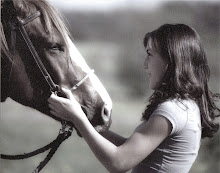
“Sellers, UP! Bailey, on deck, Schutes, in the hole,” I hear the announcer finally blare over the loud speakers. I walk my wide-eyed youngster toward the gate, and both of our hearts begin to race. After centering us in the middle of the fence line, I pick up the right hand rein and Rooster spins around, heading for the first barrel. We make a surprisingly smooth right hand turn and dart to the second barrel. I am unable to hold him away from it as he lowers his shoulder and knocks over the barrel halfway through the left hand turn. Still, we’re off to the third barrel at a daring speed. I sit down and pick up on the left rein, he lowers his rear end and we glide easily through the final left hand turn. Rooster lets it all burn as I push him through the timer. It was a fast run, but knocking that second barrel will kick us out of the money for sure.
Identifying the Problem:I’ve been barrel racing for 11 years now, and thought I really knew what I was doing. I started out on an old horse when I was younger, and he pretty much taught me how to do it. Now I have a young horse, Rooster, who I’ve started on my own from scratch. I broke him to lead, ride and—most recently—to run the
barrel pattern (which is why I bought him in the first place). However, I have not been able to cure the constant problem of him shouldering into the second barrel and knocking it over all of the time. I’ve tried many things, and nothing that I knew to work on seemed to help. Finally I searched out someone who could help.
Getting Some Advice:Larry Teubert is very experienced when it comes to barrel racing. He makes his living training other people’s horses as well as training and running his own. I have worked with him over the summer for two years at
Hickory Hills Thoroughbred Farm in Michigan. I finally thought it best to ask his advice about fixing Rooster. “You need to start by getting him to break at the poll and give to leg pressure,” he told me. I remembered being at a clinic a few years ago, put on by a very prestigious trainer,
John Lyons. By using his method for training a horse to give and break at the poll, I would be able to easily start Rooster in a better direction. By using leg pressure while turning a barrel, I would be able to hold Rooster away from it without pulling too hard on his mouth. By pulling on his mouth a lot, I was tipping his nose away from the barrel, and he couldn't see the barrel, which, in turn, he ran over. I’ve been working with him on these things and he’s doing much better. To get him to stop cutting off so soon, Larry urged me to run him to the fence, so that Rooster has to listen to me and stops guessing and getting ahead of himself when making the turn. I had never thought of that. I had been so focused on getting him to learn the pattern that it never occurred to me to try to trick him into listening.
Larry also told me to try a different bit. Rooster seemed to always be fighting the regular
snaffle, so I decided to try a
hackamore. Rooster seems to be much happier with this kind of bit. He doesn’t throw his head around as much which gives me more control, and allows him to concentrate more on the task at hand. A hackamore doesn’t have as much pull sideways, but since I’ve been working with Rooster on breaking at the poll, he doesn’t need as harsh of a bit.
Moving OnSo here I was, I thought I knew just about all there was to know about barrel racing. As it turns out, I couldn’t even do some of the important basics. It took me running into a wall (almost literally) before I came to realize that I had to be missing something.
“Sellers UP! Dennis, on deck. Johnson, in the hole.” Well, here goes nothing. It’s time to see if my work has paid off. We move toward the entry gate. As always, I feel our two hearts racing. Three barrels, two hearts, one dream—all in a race against time.





